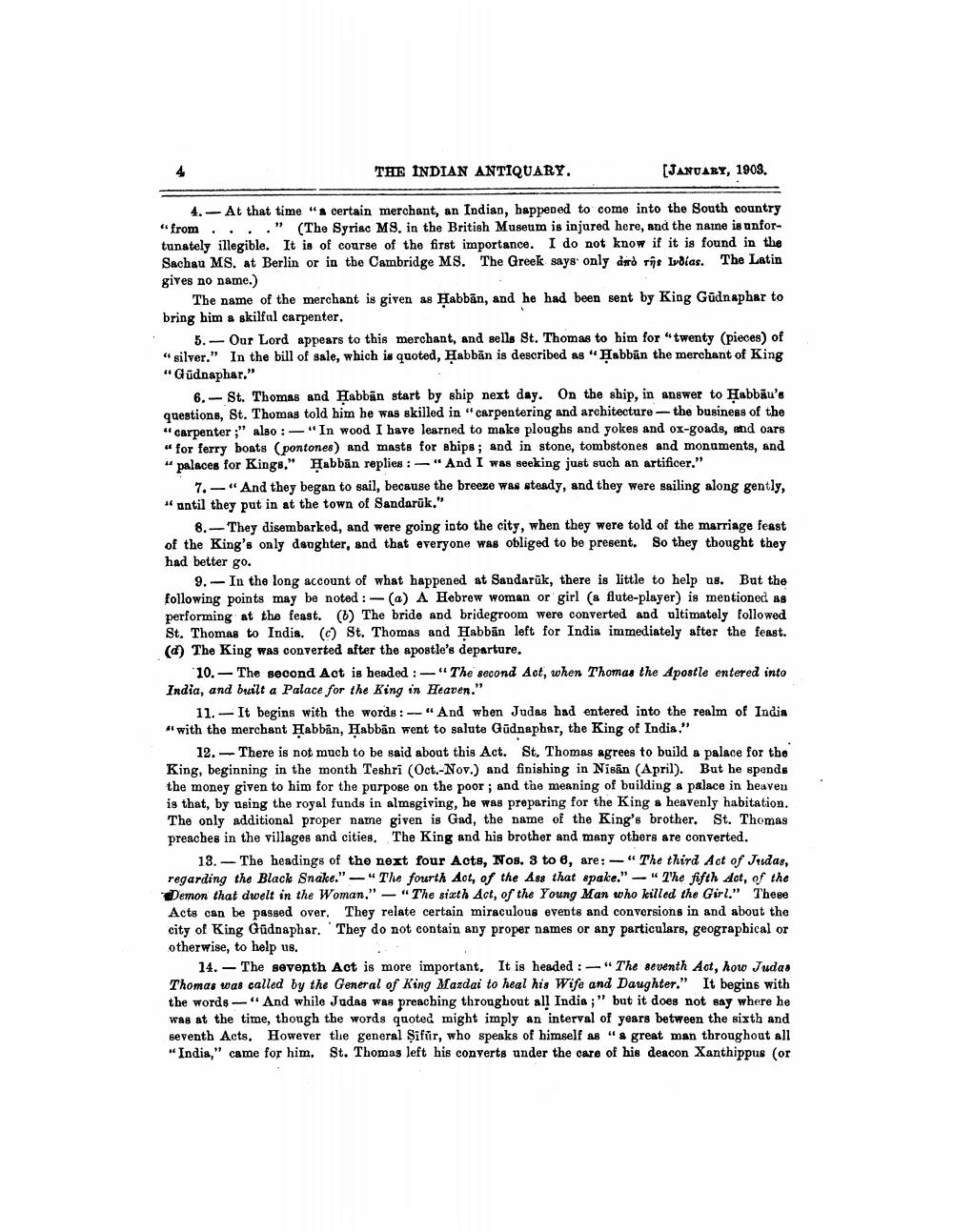________________
THE INDIAN ANTIQUARY.
(JANUARY, 1903.
4. - At that time " certain merchant, an Indian, happened to come into the South country "from ...." (The Syriac MS. in the British Museum is injured here, and the name is unfortunately illegible. It is of course of the first importance. I do not know if it is found in the Sachau MS. at Berlin or in the Cambridge MS. The Greek says' only did rît Ivdias. The Latin gives no name.)
The name of the merchant is given as Habbān, and he had been sent by King Gūdnaphar to bring him a skilful carpenter.
5.- Our Lord appears to this merchant, and sells St. Thomas to him for “twenty (pieces) of "silver." In the bill of sale, which is quoted, Habban is described as " abban the merchant of King "Gūdnaphar."
6.- St. Thomas and Habban start by ship next day. On the ship, in answer to Habbau's questions, St. Thomas told him he was skilled in "carpentering and architecture - the business of the "Carpenter;" also :-"In wood I have learned to make ploughs and yokes and ox-goads, and oars
for ferry boats pontones) and masts for ships; and in stone, tombstones and monuments, and palaces for Kings." Habban replies : -"And I was seeking just such an artificer."
7.-"And they began to sail, because the breeze was steady, and they were sailing along gently, " until they put in at the town of Sandarük."
8.- They disembarkod, and were going into the city, when they were told of the marriage feast of the King's only daughter, and that everyone was obliged to be present. So they thought they had better go.
9. - In the long account of what happened at Sandarük, there is little to help us. But the following points may be noted :-(a) A Hebrew woman or girl (a flute-player) is mentioned as performing at the feast. (b) The bride and bridegroom were converted and ultimately followed St. Thomas to India. (©) St. Thomas and Habbān left for India immediately after the feast. (d) The King was converted after the apostle's departure.
10.- The second Act is headed : -"The second Act, when Thomas the Apostle entered into India, and built a Palace for the King in Heaven."
11.-It begins with the words : -"And when Judas had entered into the realm of India " with the merchant Habban, Habbãn went to salute Gūdnaphar, the King of India,"
12. There is not much to be said about this Act. St. Thomas agrees to build a palace for the King, beginning in the month Teshri (Oct.-Nov.) and finishing in Nisan (April). But he spends the money given to him for the purpose on the poor; and the meaning of building a palace in heaven is that, by using the royal funds in almsgiving, he was preparing for the King a heavenly habitation. The only additional proper name given is Gad, the name of the King's brother. St. Thomas preaches in the villages and cities. The King and his brother and many others are converted.
18. - The headings of the next four Acts, Nos. 3 to 6, are: - "The third Act of Judas, regarding the Black Snake." - "The fourth Act, of the Ass that spake." — " The fifth Act, of the Demon that dwelt in the Woman." - "The sixth Act, of the Young Man who killed the Girl.” These Acts can be passed over. They relate certain miraculous events and conversions in and about the city of King Gūdnaphar. 'They do not contain any proper names or any particulars, geographical or otherwise, to help us.
14.- The seventh Act is more important. It is headed : -"The seventh Act, how Judas Thomas was called by the General of King Mazdai to heal his Wife and Daughter." It begins with the words - "And while Judas was preaching throughout all India ;" but it does not say where he was at the time, though the words quoted might imply an interval of years between the sixth and seventh Acts. However the general Şifür, who speaks of himself as "* great man throughout all "India," came for him. St. Thomas left his converts under the care of his deacon Xanthippus (or




